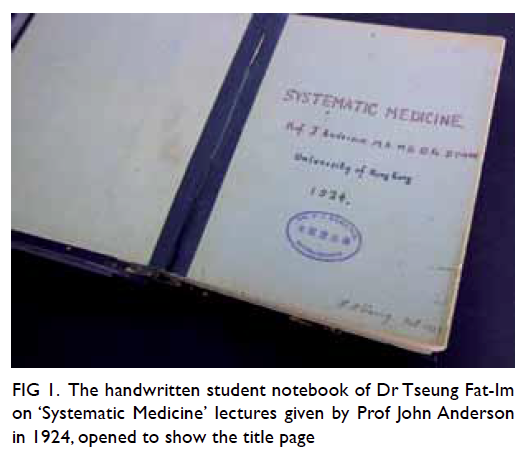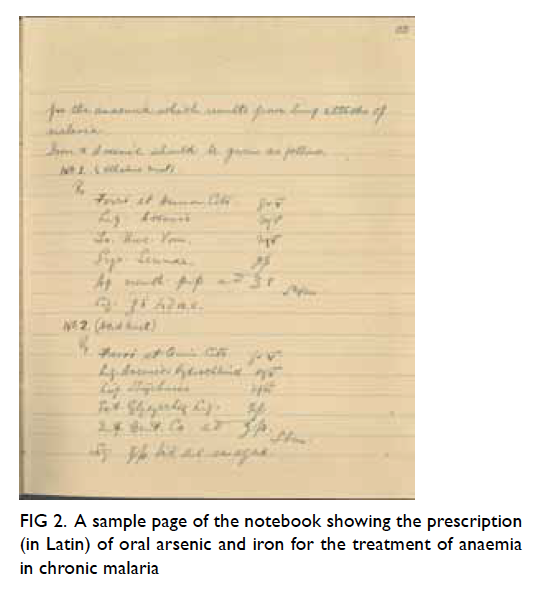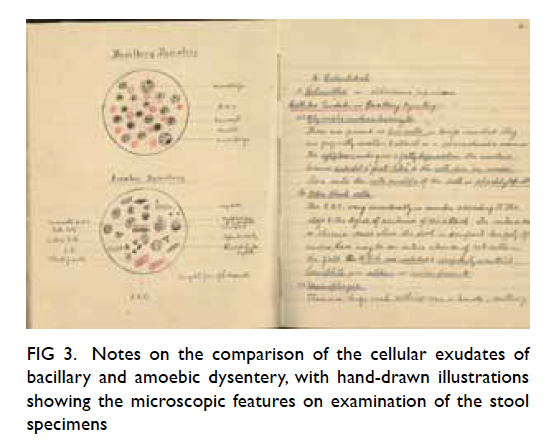© Hong Kong Academy of Medicine. CC BY-NC-ND 4.0
REMINISCENCE: ARTEFACTS FROM THE HONG KONG MUSEUM OF MEDICAL SCIENCES
Dr Tseung Fat-Im’s notebook of Professor Anderson’s Lectures, 1924
Faith CS Ho, MD, FHKAM (Pathology)
Member, Education & Research Committee, Hong Kong Museum of Medical Sciences Society
Dr Tseung Fat-Im (蔣法賢 1903-1975) was one of
Hong Kong’s most notable medical doctors of the
mid-20th century. He graduated MB BS from the
University of Hong Kong in 1925, having entered the
medical faculty from Queen’s College in 1920 with
a scholarship awarded by the Kwangtung provincial
government,1 8 years after the university opened
its doors in 1912. Dr Tseung also recalls that one
of the most memorable occasions of his student life
was listening to Dr Sun Yat-Sen when he addressed
the gathering at the Great Hall of the university in
1923. As a senior student, he was taught by the newly
appointed Professor John Anderson, who held the
first full-time post of professor of medicine of the
university from 1923 to 1928, a post funded by a grant
from the Rockefeller Foundation. After graduating
in Arts (1901), Science (1904), and Medicine (1906)
from the University of Glasgow, John Anderson
spent 7 years in general practice before serving as
a Captain in the Royal Army Medical Corps during
the First World War and becoming a specialist in
field laboratory work.2 3 After the war, he joined the
London School of Hygiene and Tropical Medicine
(LSHTM) in 1920 and was engaged in research work
in tropical medicine in programmes led by Patrick
Manson and his associates before his appointment
to the Chair of Medicine in Hong Kong.
The notebook of Dr Tseung that features in
this article (Fig 1) shows the handwritten notes he
took during lectures in Systematic Medicine given
by Professor Anderson in 1924. It is a bound volume
and contains 186 pages, being one of two such
notebooks of Dr Tseung in the collection of the Hong
Kong Museum of Medical Sciences. The second
notebook comprises notes taken during Professor
Wang Chung-Yick’s lectures on bacteriology. Both
were donated to the museum by Dr Shiu Yuk-Tong
in 2001.

Figure 1. The handwritten student notebook of Dr Tseung Fat-Im on ‘Systematic Medicine’ lectures given by Prof John Anderson in 1924, opened to show the title page
The notebook is especially valuable not only
because of the personalities with which it was
associated, but also because it gives a rare glimpse
into medical practice in the 1920s, the prevalence
of infectious diseases, the meticulously detailed
description of their pathology and differential
diagnoses using laboratory methods, and the often
innovative but limited range of treatments that were
at the disposal of medical practitioners in the pre-antibiotic
era. For example, we find descriptions
of the use of intravenous tartar emetic (antimony
potassium tartrate) in clonorchiasis, schistosomiasis,
and as treatment for sleeping sickness and kala azar.
The use of arsenical compounds was also frequently
referred to, including the rather unusual description
of oral arsenic (Neosalvarsan) and iron in liquid
form as agents for the treatment of the anaemia
that accompanied chronic malaria (Fig 2). Here and
there we find references to the work of Manson and
Cantlie, and to the book Manson’s Tropical Diseases
edited by Dr Philip Manson-Bahr, Manson’s son-in-law, who was also working in the LSHTM at the
time.

Figure 2. A sample page of the notebook showing the prescription (in Latin) of oral arsenic and iron for the treatment of anaemia in chronic malaria
The notebook is also special because of its
remarkably beautiful illustrations (See Fig 3 as an example). No doubt this was largely because the
drawings originated from an exceptionally gifted
teacher who was known for his talent in drawing
and exemplified in a memoir4 that he wrote and
illustrated after a research expedition in 1921 to
British Guiana to study filariasis.2 We also, however,
cannot ignore the skill and painstaking effort
shown by Dr Tseung, the student, in reproducing the drawings. This care, attention to detail, and dedication to his studies and his work characterised Dr Tseung, the physician, all his life.

Figure 3. Notes on the comparison of the cellular exudates of bacillary and amoebic dysentery, with hand-drawn illustrations showing the microscopic features on examination of the stool specimens
After graduation, Tseung Fat-Im first served as Clinical Assistant to Professor Anderson at the Government Civil Hospital before entering private practice. In 1934 he went on a study trip to Japan, the US, then across the Atlantic to the UK and Europe before he settled back in Hong Kong, and never looked back. There is insufficient space in this article to recount all his achievements as a doctor and in community and public service; his involvement spanned free medical clinics in the New Territories, work with the Hong Kong Anti-Tuberculosis Association, the Hong Kong Anti-cancer Society, Chairman of the Hong Kong Chinese Medical Association, member of the Medical Board, Commissioner of the St John Ambulance Brigade, work with the Po Leung Kuk, the Rotary Club, the Boy Scouts Association, St. Christopher’s Home, Hong Kong Society for the Protection of Children, and much more.5 But perhaps the most significant of his achievements in the field of education was his role in the inception of the Chinese University of Hong Kong. Being also a Chinese scholar, he first served as Chairman of the Board of Trustees and President of United College, then as Chairman of the Chinese Colleges Joint Council. In this last role he played a critical part in bringing about the start of Hong Kong’s second university that was announced at a press conference held by the Director of Education and Dr Tseung in 1959.6 It is not surprising that Dr Tseung received numerous honours from the Hong Kong Government and other organisations, and was awarded an honorary doctorate of law from his Alma Mater in 1969.
In his personal life he was also blessed. In 1943 he married Ms Tso Lai-Ki (曹麗姬), the daughter of the Hon. Tso Seen-Wan (曹善允), a lawyer and early Chinese member of Hong Kong’s Legislative Council. His father-in-law followed in Sir Kai Ho Kai’s (何啟) footsteps, being involved in many public services in the field of medicine and most notably helping to start the old Tsan Yuk Hospital in 1922. The couple had a daughter and a son, and frequently worked closely together in supporting many worthwhile causes.
References
1. Ho TW. Memorial album for the late Dr. F. I. Tseung. Dr. Tseung’s memoir is recorded as a script of a talk (in Chinese) delivered to a meeting of the Rotary Club. Goldwind Photo Typesetting Co; 1977: 8-11.
2. King G. An address given on the occasion of the award of the Anderson Gold Medal to Dr. Low Nan Wan in Kuala Lumpur on Dec 6, 1952 (personal collection of the author, from Mrs. Gordon King).
3. Obituary. Prof. John Anderson. Lancet 1931;217:832.
4. Memoir No. 7. London School of Tropical Medicine; 1924.
5. For more details of Dr. Tseung’s public service, see Citation by the public orator, Prof. Leonard Kenneth Young, on award of Doctor of Laws (honoris causa) to Dr. Tseung Fat Im in 1969. Available from: http://www4.hku.hk/hongrads/index.php/citation. Accessed 22 Sep 2015.
6. Ho TW. Memorial album for the late Dr. F. I. Tseung. Goldwind Photo Typesetting Co; 1977: 125.

